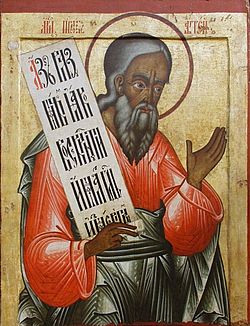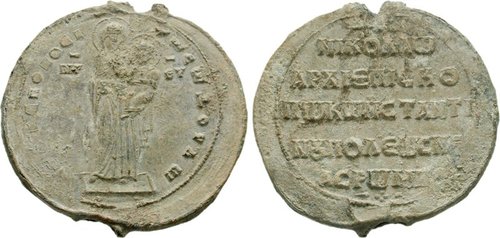Top Qs
Timeline
Chat
Perspective
December 16 (Eastern Orthodox liturgics)
Day in the Eastern Orthodox liturgical calendar From Wikipedia, the free encyclopedia
Remove ads
December 15 - Eastern Orthodox liturgical calendar - December 17

All fixed commemorations below celebrated on December 29 by Eastern Orthodox Churches on the Old Calendar.[note 1]
For December 16, Orthodox Churches on the Old Calendar commemorate the Saints listed on December 3.
Saints
- Prophet Haggai (Aggaeus) (500 BC)[1][2] (see also: December 4, July 4)
- Martyr Marinus of Rome (283)[3][4]
- Martyrs Promus (Probus) and Hilary, by the sword.[5][6][note 2]
- Saint Memnon, Archbishop of Ephesus (c. 440)[7][note 3]
- Saint Modestus II, Patriarch of Jerusalem (634)[6][8][9][10][note 4][note 5] (see also December 18 - Modestus I)
- Saint Simeon, Archbishop of Antioch (834-840)[6][11][note 6]
- Blessed Empress Theophania of Byzantium (893), wife of Byzantine Emperor Leo VI the Wise.[12][13]
- Saint Nicholas Chrysoberges, Patriarch of Constantinople (995)[14]
Remove ads
Pre-Schism Western saints
- Martyrs Valentine, Concordius, Navalis and Agricola, martyrs venerated in Ravenna in Italy. (c. 305)[15][note 7]
- Women Martyrs of North-West Africa, a great number of women martyred under Hunneric, Arian King of the Vandals (482)[15][note 8]
- Saint Dabheog (Beoc, Beanus, Mobeoc), founder of a monastery on an island in Lough Derg in Donegal in Ireland (5th century)[15]
- Saint Ado of Vienne (875)[15][note 9]
- Saint Adelaide of Italy, daughter of the King of Burgundy, she was married to Lothair II of Italy, became a nun (999)[15][note 10]
Remove ads
Post-Schism Orthodox saints
- Saint Sophia of Suzdal, nun (Solomonia Saburova), wife of Grand Duke Basil III of Moscow (1542)[10][17]
New martyrs and confessors
- New Hieromartyr Vladimir Alexeyev, Priest, of Okhansk (1918)[6][10][18]
- New Hieromartyr Arcadius (Ostalsky), Bishop of Bezhetsk (1937)[6][10][note 11]
- New Hieromartyr Alexander Kolokolov, Protopresbyter of Tver (1937)[6][18]
- New Hieromartyr Paul Favoritov, Priest of Tver (1937)[6][18]
- New Hieromartyr Macarius Smirnov, Priest-monk of Tver (1937)[6][18][19]
- New Hieromartyr Peter Zinoviev, Priest of Tver (1937)[6][18]
- New Hieromartyr Theodosius Boldiriev, Priest of Tver (1937)[6][18]
- New Hieromartyrs Priests Elias Cheredeev, and Vladimir Damaskinus (1937)[18][19]
Icon gallery
- Prophet Haggai, Russian icon from first quarter of 18th century
- Saint Theophano and her husband the emperor Leo IV the Wise.
- Saint Theophano (Menologion of Basil II, 10th century)
- Seal of Patriarch Nicholas II Chrysoberges.
- First Page of Martyrologium of Ado Viennensis. Edition: Rome, 1745.
- Saint Adelaide of Italy.
- St. Sophia of Suzdal.
- New Hieromartyr Arcadius (Ostalsky), Bishop of Bezhetsk.
- New Hieromartyr Arcadius (Ostalsky), Bishop of Bezhetsk - after NKVD tortures.
Remove ads
Notes
- The notation Old Style or (OS) is sometimes used to indicate a date in the Julian Calendar (which is used by churches on the "Old Calendar").
The notation New Style or (NS), indicates a date in the Revised Julian calendar (which is used by churches on the "New Calendar"). - They may be the same commemorated in December 19. (Elias + Ares = Hilary?)
- Certain Synaxaria mistakenly refer to him as the Bishop of Jerusalem.
- "When the Persian King Chosroes II was advancing on Jerusalem in 614, Patriarch Zacharias sent Modestus through the enemy lines to ask help of the imperial forces stationed at Antioch. The Holy City fell to the Persians after a three-week siege and, for three days, was thoroughly pillaged and was the scene of dreadful massacres. As the holy Patriarch Zacharias (21 Feb.), along with the Holy Cross and thousands of Christians, had been deported to Persia, Modestus was chosen to succeed him in the still smouldering city. Braving death at every moment, the Saint, like a second Zerubbabel, saw to the burying of the tens of thousands of victims and to the cleansing of the devastated and profaned sanctuaries and holy places. He brought together, consoled and gave hope to the survivors, and thanks to unstinted aid from Saint John the Merciful, the Patriarch of Alexandria (12 Nov.), he was able to restore life to the afflicted Church of Sion, bereft of all resource."[8]
- Born in Burgundy in France, he became a monk at Prüm near Trier in Germany. From here he travelled to Rome. On his return he became Bishop of Vienne and was an excellent bishop. He is remembered for the martyrology which bears his name.
- She was rescued from brutality after his death by Otto the Great who married her. Widowed again, she was maltreated by her son and daughter-in-law. In old age she became the regent of the Empire. At the end of her life she became a nun.
- See: (in Russian) Аркадий (Остальский). Википедии. (Russian Wikipedia.)
Remove ads
References
Sources
Wikiwand - on
Seamless Wikipedia browsing. On steroids.
Remove ads









